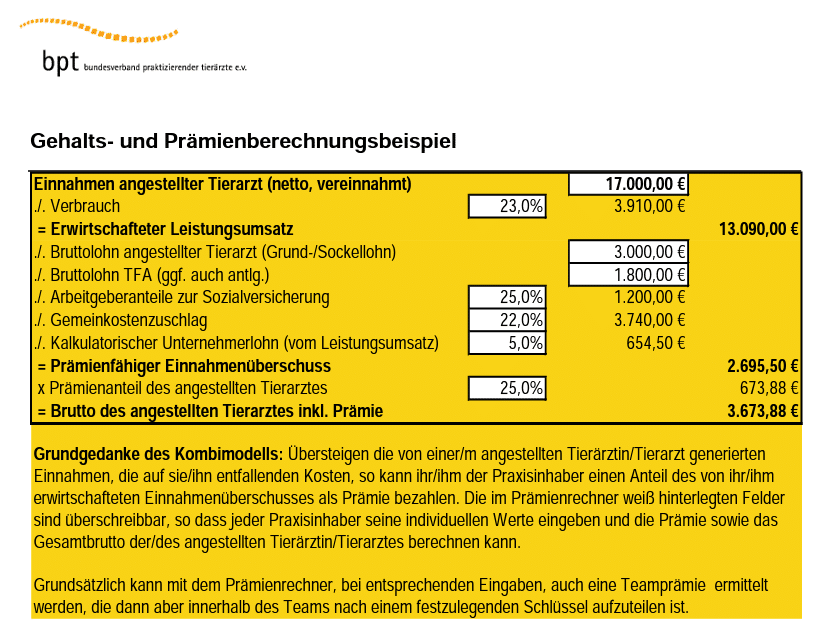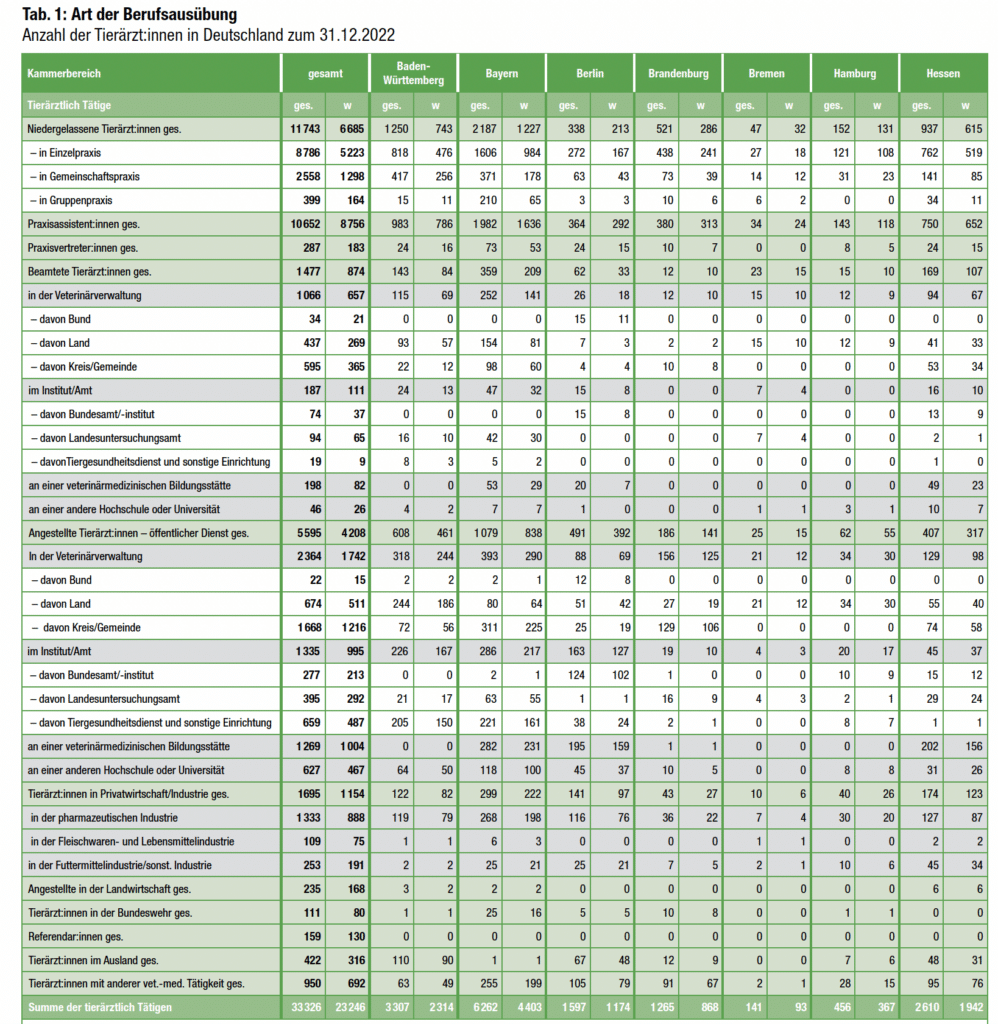- Salary and working hours for veterinarians: A current overview & discussion
- Salary of employed veterinarians: what can you expect?
- Reality check: How much do veterinarians actually earn?
- Salary and working hours for veterinarians: Starting salary for a veterinarian
- Salary and working hours for veterinarians: Salary development over the course of your career
- Salary and working hours of veterinarians: specialization and salary
- Salary and working hours for veterinarians: Regional salary differences for veterinarians in Germany
- Salary and working hours for veterinarians: What remains at the end of the day - is it better to have more gross or more net?
- Working hours for veterinarians: Legal framework
- Working time models for veterinarians in Germany
- How many veterinarians are women and men, differentiated between small animal and large animal physicians
- How many veterinarians are self-employed, employed, in public service, etc.?
- A few suggestions for discussion about making the veterinary profession more attractive in terms of salary and working hours?
- Short Summary
- discussion
Salary and working hours for veterinarians: A current overview & discussion
Veterinarians provide an invaluable service to the health of our animals. But what about their income and working time prospects? We offer you a detailed overview of the salary structures and working hours for veterinarians in Germany.
With the animal docs , SWR3 has recently found a new enemy - the greedy veterinarian. But what is it about the rich veterinarians who take every last bit of money out of the patient owners' pockets and what is the reality?
Salary of employed veterinarians: what can you expect?
Salary and working hours for veterinarians: basis for negotiation instead of collective agreements
There are currently no fixed collective agreements for veterinarians. This means that salaries are often a matter of negotiation. However, various interest groups offer guidance:
- Federal Veterinary Association (BTK) : For career starters, the salary recommendation is between 3,130.00 euros up to the sixth month and increases to 3,657.00 euros from the seventh month.
- Association of Employed Veterinarians (BaT) : The recommendation starts with a starting salary of 3,710.00 euros up to the sixth month and increases to 4,102.00 euros from the seventh month.
- Federal Association of Practicing Veterinarians (bpt) : The recommendation starts at 3,500 euros in the first year and increases to a maximum of 5,090 euros from 14 years of practice.
The last example in particular shows the crux of these relatively high starting salary requirements - nothing can be met later. The BPT also states this quite openly - it expects a 2% annual salary increase and this with inflation currently >6%. Can this be motivating?
The proposed BPT premium model is more exciting, even though it is economically very simplified and ignores essential business principles such as additional wage costs. Nevertheless, we believe that this can be more exciting and provides more performance incentives than a low annual salary adjustment.
Salary and working hours for veterinarians: salary models at a glance
The bpt also presents two models:
- Fixed salary model : A monthly salary of EUR 3,089.00 to EUR 3,546.00 is suggested here for a 40-hour week.
- Bonus model : This model recommends a base salary of around 3,000.00 euros, supplemented by a performance-related bonus that is between 25 and 35 percent of sales.

Reality check: How much do veterinarians actually earn?
Salary and working hours for veterinarians: Starting salary for a veterinarian
A newly qualified veterinarian can expect a gross salary of around €45,000 to €55,000 per year. Of course, this depends on the region, the specific practice and the working hours.
Salary and working hours for veterinarians: Salary development over the course of your career
As a veterinarian gains experience, he or she can expect a significant increase in his or her salary. After five years in the job, the average annual salary is around €60,000 to €75,000.
Salary and working hours of veterinarians: specialization and salary
Veterinarians who specialize in certain animal species or medical fields can often expect a higher salary. For example, an equine veterinarian or an animal surgeon can earn up to €80,000 or more.
Salary and working hours for veterinarians: Regional salary differences for veterinarians in Germany
In Germany, salaries in many professions vary depending on the region. This also applies to the veterinarian's salary (salary and working hours for veterinarians:). The following examples show how the salary of a veterinarian can vary in different cities and states (source Stepstone).
Salary and working hours for veterinarians: large cities and metropolitan areas
- Munich : As the state capital of Bavaria and one of the most expensive cities in Germany, veterinarians here can expect an above-average salary. This is often between €65,000 and €80,000 per year.
- Berlin : Despite its role as the capital, the cost of living in Berlin is often lower than in other major cities. The average salary for veterinarians here is between €58,000 and €73,000.
- Frankfurt am Main : As a financial center, Frankfurt offers high salaries in many industries. Veterinarians can expect salaries between €62,000 and €77,000.
- Hamburg : In the Hanseatic city of Hamburg, the average salary for veterinarians is between €60,000 and €75,000.
- Düsseldorf : In the heart of North Rhine-Westphalia, veterinarians can expect an annual salary of €59,000 to €74,000.
Salary and working hours for veterinarians: Rural regions and smaller cities
- Schleswig-Holstein : In more rural areas such as Schleswig-Holstein, the average salary for veterinarians can range between €50,000 and €65,000.
- Saxony-Anhalt : Here, veterinarians can expect a salary of €48,000 to €62,000.
- Thuringia : In this region, the average salary for veterinarians is between €47,000 and €61,000.
- Rhineland-Palatinate : Veterinarians in Rhineland-Palatinate can expect salaries between €51,000 and €66,000.
- Baden-Württemberg : In rural areas of Baden-Württemberg, the salary can vary between €53,000 and €68,000.
Salary and working hours for veterinarians: What remains at the end of the day - is it better to have more gross or more net?
Anyone who is an optimist and believes in the state pension system and is also naive enough to believe that the well-filled pension schemes of freelancers (lawyers, tax advisors, doctors and even veterinarians) will not one day be included in the state redistribution system will always prefer higher gross remuneration.
All the others prefer higher net wages in order to be able to make provisions for their old age on the one hand and, on the other hand, to save for their own practice if necessary:
A veterinarian's salary can be influenced by various components. Some of these salary components are fixed components of the base salary, while others may be variable or performance-related. Here are some components that can positively influence a veterinarian's net income in Germany:
- Basic salary: The basic salary determined by the employment contract.
- Overtime and night pay: Veterinarians who work outside of normal working hours often receive pay for overtime, night work, or work on Sundays and holidays.
- Emergency Service Pay: Veterinarians working in an emergency service system may receive additional payments for these services.
- Bonus systems: Some veterinary practices or clinics may have a bonus system based on performance or sales.
- Further training and qualification supplements: Veterinarians who have acquired additional qualifications or specialized training (e.g. veterinary specialist) can often negotiate a higher salary.
- Company pension plan: Some employers offer a company pension plan, which does not directly increase net earnings, but offers long-term financial advantages.
- Benefits in kind: Some employers offer benefits in kind such as company cars, free accommodation or company cell phones.
- Private Veterinary Assistant Insurance: In some cases, veterinarians may benefit from private health insurance for their animals.
- Participation in research projects or industry collaborations: Some veterinarians can earn additional income by participating in scientific studies or collaborations with the pharmaceutical industry.
- Self-employment and practice ownership: Self-employed veterinarians or practice owners often have higher income potential, but also carry greater financial risk.
It is important to note that not all veterinarians can benefit from all of these salary components, as many factors, such as work location, practice size, specialization and professional experience, affect salary. Negotiating and knowing your own market value can also be crucial to getting the best possible salary.

Working hours for veterinarians: Legal framework
Although there is no specific collective agreement for veterinarians, they are subject to the German Working Hours Act. This ensures that working hours and rest periods are set by law.
Working time models for veterinarians in Germany
The profession of a veterinarian is varied and demanding. Depending on the specialization, working hours and models can differ significantly. Below we offer you an overview of the working time models that are common for small animal doctors, equine veterinarians and large animal doctors in Germany (salary and working hours for veterinarians).
Small animal medicine specialist
Full-time practice:
- Typically a 5-day week with fixed office hours.
- Emergency services, especially on weekends or public holidays.
Part-time practice:
- Reduced working hours, often in larger practices or clinics with multiple veterinarians.
- Emergency services can be regulated jointly.
Flexible working time model:
- Adjusted working hours, for example through flexitime or block working hours.
- Possible in larger clinics or practice groups.
Equine veterinarians
Full-time practice:
- Often irregular working hours due to home visits.
- Emergency services and weekend work are common.
Seasonal working hours:
- More intensive work phases during the tournament season or breeding season.
Part-time or flexible models:
- Possible if working in a group practice or clinic.
- Emergency services are divided among the team.
Large animal medicine specialist
Full-time practice:
- Frequently irregular working hours due to home visits, often in rural areas.
- On-call duty and weekend work are standard.
Seasonal working hours:
- Peak phases during the birth and mating periods of farm animals.
Part-time or job sharing:
- Rare, but possible in larger practices or cooperatives.
- Allows sharing of on-call and emergency services.
Collaboration with farmers:
- Possible model in which veterinarians cooperate directly with farms or agricultural businesses and plan regular visits.
How many veterinarians are women and men, differentiated between small animal and large animal physicians
As of 2021, the profession of veterinarian has developed into a predominantly female-dominated profession in many countries, including Germany. However, the exact numbers can change from year to year.
In Germany, over the years, more and more women have been working in veterinary medicine, and this trend has continued. While there used to be a more even distribution between men and women, women are in the majority among younger generations of veterinarians.
However, the ratio of women to men may differ depending on the specialization:
- Small animal medicine: Women clearly dominate here. This may be due in part to flexible working hours and the physical demands of the job.
- Large animal medicine: Historically, this field has been male-dominated, primarily due to the physical demands and often necessary travel. However, here too there is an increase in women in large animal practice, although men may still be in the majority in this field.
- Equine medicine: The gender ratio could be a little more balanced here, although the trend towards female dominance can also be observed in this area.
How many veterinarians are self-employed, employed, in public service, etc.?

Of the total of 33,326 veterinarians working in 2022, only 22,682 worked in a practice or clinic; the rest were civil servants, employed in the pharmaceutical industry or otherwise employed. In other words, 68% went straight into the job they actually studied. This may sound strange, but it is intended to point out the personnel predicament we find ourselves in as veterinarians and with whom the veterinarians in the country have to compete for employees.
In addition, 11,292 veterinarians were no longer working as veterinarians or were working without pay. In other words, 50% of trained veterinarians are missing out on “normal” veterinary care for small animals, large animals or horses.
A few suggestions for discussion about making the veterinary profession more attractive in terms of salary and working hours?
In order to make the profession of veterinarian more attractive in terms of both salary and working hours, various approaches could be pursued. However, it is important to note that any change should be carefully considered and implemented taking into account all relevant factors to avoid unwanted side effects or negative effects on animal health. Here are some suggestions:
Salary:
- Performance-related bonuses: Additional bonuses for outstanding performance or for treating special cases can have a motivating effect.
- Continuing Education Support: Financial support or participation in the cost of continuing education can indirectly increase income by enabling veterinarians to become skilled in high-paying specialties.
- Company pension scheme/company health insurance: Some employers could make contributions to company pension schemes, which represents a financial incentive in the long term.
Working hours:
- More flexible working hours: More flexible working hours, for example through flexitime models, could be very attractive, especially for veterinarians with families.
- Part-time work: The ability to work part-time without resulting in a disproportionate loss of salary.
- Job sharing: Two veterinarians could share a job, allowing both more free time.
- Regular breaks: Particularly in veterinary medicine, where emergencies are common, it should be ensured that veterinarians can take regular breaks.
- Clearly defined emergency services: Instead of constant on-call availability, clearly structured emergency service times could be established that rotate between veterinarians.
- Technological support: Investments in modern technologies could automate routine tasks and reduce workload.
Short Summary
The discussion about “salary and working hours for veterinarians” shows considerable differences in the regions of Germany. When it comes to “salary and working hours for veterinarians”, young graduates face particular challenges. Adjusting “salary and working hours for veterinarians” could make the profession more attractive. “Salary and working hours as veterinarians” influence the career choice of many students. Many associations are trying to create transparency regarding “salary and working hours for veterinarians”.
The debate about “salary and working hours for veterinarians” reflects social appreciation. In order to improve “veterinarians’ salaries and working hours” in the long term, reforms are necessary. “Salary and working hours of veterinarians” also influence patient care. Investments in “salary and working hours for veterinarians” could counteract the shortage of skilled workers. Without adjustments to “veterinarians’ salaries and working hours,” many practices could close. It is essential that "veterinarians' salaries and working hours" are given greater consideration in political discussions.
discussion
The professional world of veterinarians in Germany is facing a breaking point. While the emotional and professional stress is constantly increasing, recognition in the form of salaries and regular working hours is often lacking. Is the current system still sustainable? Deeper insights and a critical examination of the reality of veterinary medicine are essential.
our new working time models offer some initial inspiration - but we are certainly at the beginning of a process here.
Now we look forward to your feedback and your ideas on how the wonderful profession of veterinary medicine could become more attractive again, because somewhere out there there are clearly 20 thousand trained veterinarians who have directly or indirectly turned their backs on their profession:
